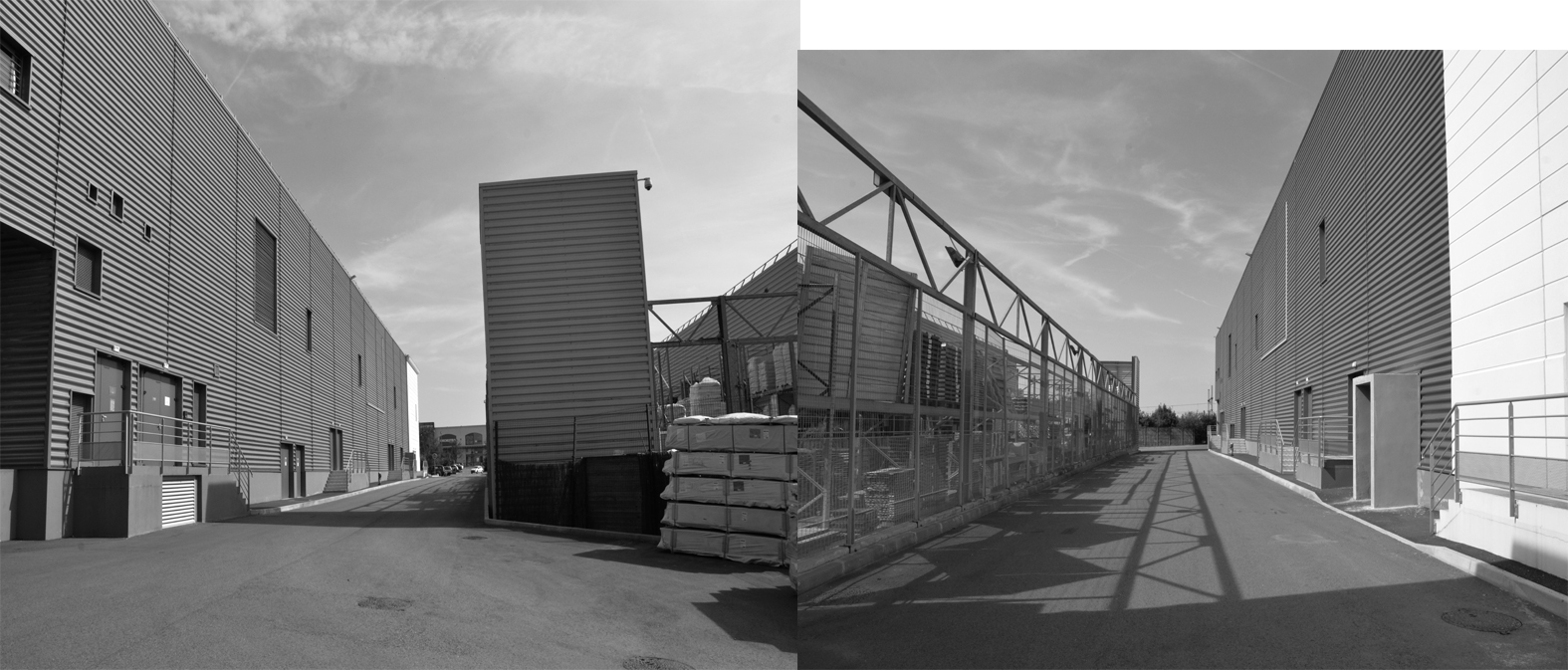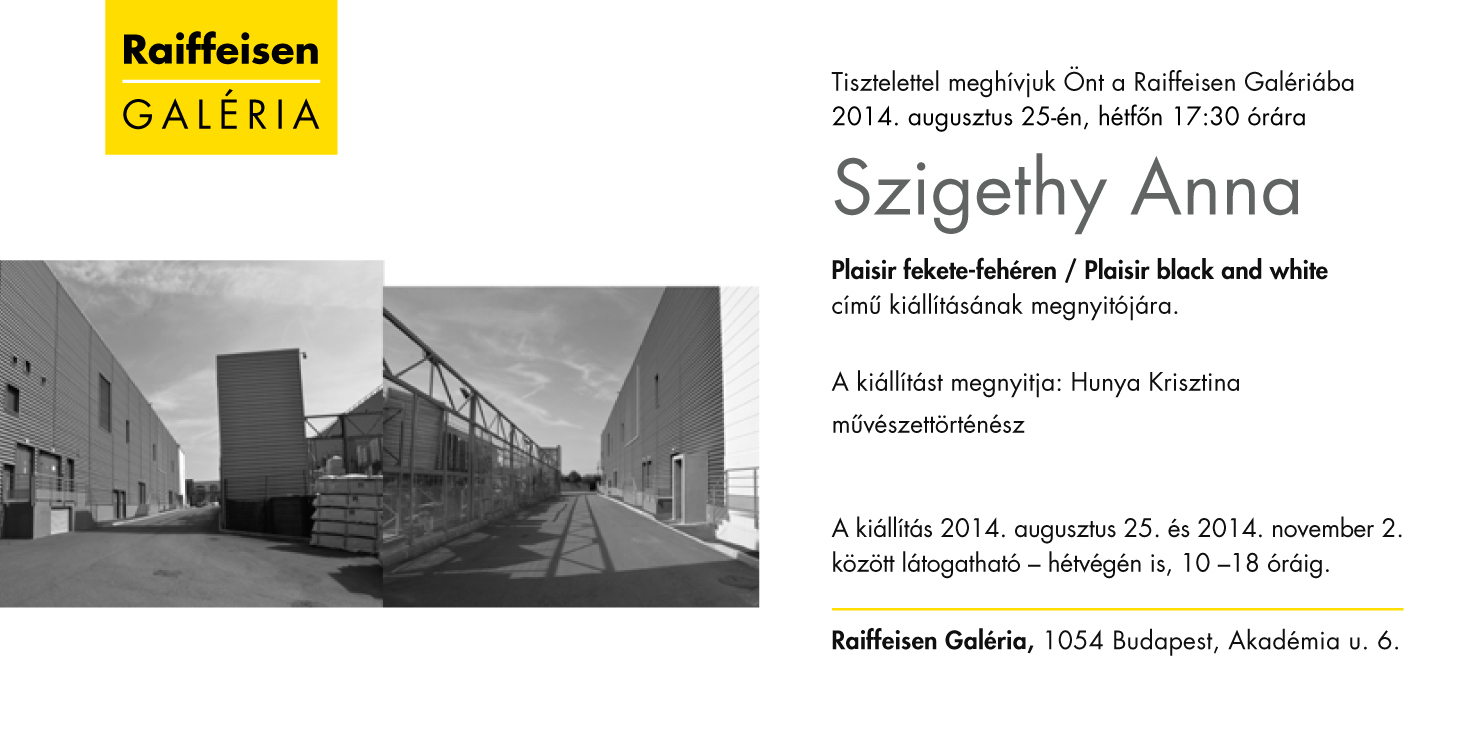Plaisir en noir et blanc - exposition individuelle
Par anna szigethy le jeudi, septembre 25 2014, 07:32 - NON-LIEU - Lien permanent
Plaisir en noir et blanc série de photo, 120x40cm, 160x40cm, 2014






Plaisir black and white
Just what is it that makes the black and white reality of suburban train stations so appealing?
Anna Szigethy’s photo series and montages invite us to a suburban walk along large concrete surfaces, empty highways, shopping malls and the meeting points of somber guys. Nature here only appears occasionally and incidentally, mainly in the form of bushes obscuring fences or young trees on the horizon. In the strong afternoon sunshine the place could easily serve as the setting for a crime story, where the lost flâneur can bear witness to suspicious or strangely everyday scenes.
As the flâneur, the city stroller coined by Walter Benjamin got aloof around boulevard arcades and shopping streets in 19th century Paris, thus Szigethy, the ‘intellectual nomad’ of the 21st century, is drawn to the commercial areas of postmodern city planning. It is not Paris in the focus of her lens anymore; we are in Plaisir – Les Clayes around 30 kilometers, a one and a half hour subway ride away from the dandy’s Montparnasse district. Although the French expression plaisir means joy and pleasure, this reference becomes humorous rather than descriptive when looking at the ‘non-places’ surrounding a dreary shopping mall. Plaisir – Les Clayes seems to be on the one hand mysteriously alien – how can one live in this place? –, as it is on the other hand strikingly familiar.
Instead of the flâneur’s pointless strolling, the artist here looks at every notion of her surrounding with empiric attention and an eagerness for documentation. Szigethy, like the visitor of the exhibition, remains an outsider having no contact with the captured figures, yet temporarily establishing a deeply empathetic and intimate relationship with the observed milieu. Capturing the artificiality of the deserted and absurd environment, on the film roll she arranges it along an impromptu visual order. The resulting photo series create imaginary narratives that reveal the aesthetics as well as a sociography of the public space at the edge of the expanding city. Though surveillance cameras monitor these ‘non-places’, symbols of extremist beliefs are telling of the despair here
Just what is it that makes the black and white reality of suburban train stations so appealing? The station becomes an emblematic platform for the 21st centuries homelessness, where anything can happen, but in reality all stands still. / Préface de Krisztina Hunya







Plaisir black and white
Just what is it that makes the black and white reality of suburban train stations so appealing?
Anna Szigethy’s photo series and montages invite us to a suburban walk along large concrete surfaces, empty highways, shopping malls and the meeting points of somber guys. Nature here only appears occasionally and incidentally, mainly in the form of bushes obscuring fences or young trees on the horizon. In the strong afternoon sunshine the place could easily serve as the setting for a crime story, where the lost flâneur can bear witness to suspicious or strangely everyday scenes.
As the flâneur, the city stroller coined by Walter Benjamin got aloof around boulevard arcades and shopping streets in 19th century Paris, thus Szigethy, the ‘intellectual nomad’ of the 21st century, is drawn to the commercial areas of postmodern city planning. It is not Paris in the focus of her lens anymore; we are in Plaisir – Les Clayes around 30 kilometers, a one and a half hour subway ride away from the dandy’s Montparnasse district. Although the French expression plaisir means joy and pleasure, this reference becomes humorous rather than descriptive when looking at the ‘non-places’ surrounding a dreary shopping mall. Plaisir – Les Clayes seems to be on the one hand mysteriously alien – how can one live in this place? –, as it is on the other hand strikingly familiar.
Instead of the flâneur’s pointless strolling, the artist here looks at every notion of her surrounding with empiric attention and an eagerness for documentation. Szigethy, like the visitor of the exhibition, remains an outsider having no contact with the captured figures, yet temporarily establishing a deeply empathetic and intimate relationship with the observed milieu. Capturing the artificiality of the deserted and absurd environment, on the film roll she arranges it along an impromptu visual order. The resulting photo series create imaginary narratives that reveal the aesthetics as well as a sociography of the public space at the edge of the expanding city. Though surveillance cameras monitor these ‘non-places’, symbols of extremist beliefs are telling of the despair here
Just what is it that makes the black and white reality of suburban train stations so appealing? The station becomes an emblematic platform for the 21st centuries homelessness, where anything can happen, but in reality all stands still. / Préface de Krisztina Hunya
